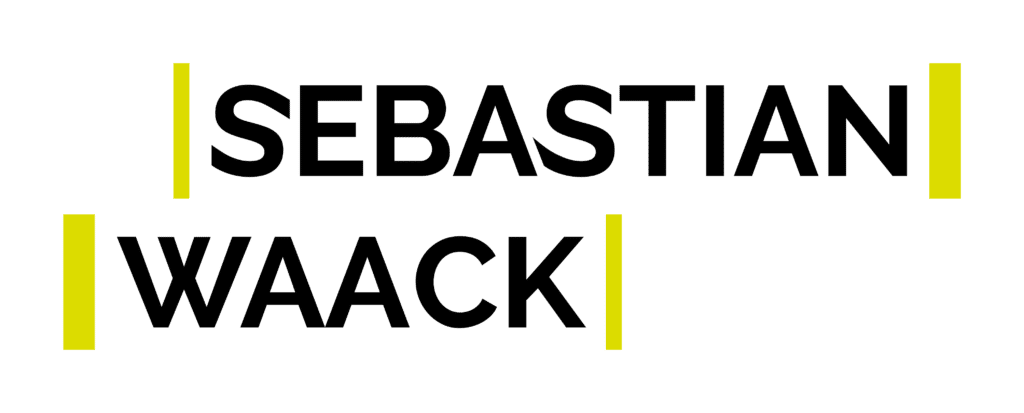More turnover. More profit. More time.
Process optimization for the building cleaning industry
Do you know the problems too?
- Insufficient resources and staff shortages.
- Outdated technologies slow down efficiency.
- Communication deficits between departments.
Stay relaxed. I have a solution.
Finally more success:
Process optimization
is your key for
better operations
Nice to have you back
Let's together
on your problems
work.
Building cleaners are constantly struggling with efficiency problems. With structured processes and advanced digitalization, you can make the difference. Increase productivity and reduce annoyance. Sebastian Waack brings a sparkle to your commercial cleaning business.
Building cleaning is more than just cleaning. Unclear communication, outdated technologies and a lack of resources can cause the industry to falter.
That’s where Sebastian Waack comes in. He delves deep into the world of commercial cleaning and provides services ranging from process documentation and digitalization to quality management.
Imagine running a smooth cleaning operation where jobs are completed efficiently and to the complete satisfaction of customers.
More shine, less stress.
Are you ready to make things sparkle?

Work Results:
Sebastian Waack helped a building cleaning company from Bavaria to significantly increase its staff utilization through targeted employee development and resource planning.
With Sebastian Waack, a cleaning service provider from Berlin has succeeded in sustainably accelerating its work processes through digitalization and the implementation of modern technologies.
In collaboration with a cleaning company in Saxony, Sebastian Waack successfully implemented an interactive communication system that reduced misunderstandings and accelerated the flow of information.
- Process documentation
- Digitization
- Inventory Management
- Employee development
- Quality management
Resource management

In building cleaning, it is important to have enough people and materials. If this is missing, there are problems.
Sebastian Waack uses new tools to know how many people and things are needed. He uses computers and training courses to make plans.
He also offers courses so that everyone can work well. This means fewer problems and better work.
Resource management and personnel planning are critical in building cleaning. A lack of both can quickly lead to delays.
Sebastian Waack implements modern tools that anticipate personnel requirements in advance and plan the optimum deployment of resources.
By linking digitalization and employee development, deployment plans are automatically created and adapted.
Workshops and training sessions also ensure that staff are always efficient and satisfied.
In this way, bottlenecks can be avoided and quality increased.
Digitization

In professions that change frequently, old techniques can cause problems.
Sebastian Waack helps companies to become modern. He uses better cleaning equipment and computer programs.
The aim is not only to be new, but also to clean better. This allows the workers to work more easily and better.
In an industry that is constantly evolving, outdated technologies can hinder progress.
With a focus on the latest digitalization solutions, Sebastian Waack brings companies up to date.
It uses advanced cleaning technologies and tools while integrating systems that optimize the workflow.
It’s not just about being modern, but also about optimizing every cleaning process so that employees can achieve more with less effort.
Communication

Good speech is important for good work. Without this, there are often mistakes that cost money.
Sebastian Waack provides tools and ways for everyone in the team to talk well. Meetings, learning and joint programs keep everyone in the team up to date.
It also helps bosses to talk better, so that everyone in the company works well together and the work is better.
Clear communication is the be-all and end-all for smooth business. Without them, misunderstandings arise that can be costly.
Sebastian Waack establishes internal communication tools and processes to ensure a seamless exchange of information.
All team members are synchronized through regular meetings, training and the use of collaborative platforms. He also trains managers in effective communication techniques to increase transparency and eliminate silos.
This ensures that all departments work in unison and service quality increases.
What do I mean by...
More details about the building blocks
Process documentation
Process documentation in the building cleaning industry: cleanliness starts with structure. Every handle fits, every detail counts. Brilliant performance in top form!
Quality management
Quality management in the commercial cleaning industry: perfection meets systematics. Every spot recognized, every method optimized. Cleanliness at the highest level!
Inventory Management
Inventory management in the building cleaning industry: control meets system. Every cleaning agent counted, every appliance localized. Efficiency in every corner!
Digitization
Digitalization in the building cleaning industry: innovation meets practice. Every click saves time, every app increases quality. Cleaning in the digital age!
Employee development
Employee development in the commercial cleaning industry: potential meets promotion. Every training course increases competence, every employee shines. Teams that shine!
What is currently the biggest challenge in your commercial cleaning company?
I'm thinking... give me 5 seconds ...
Real case studies of my work as a process optimizer in the building cleaning industry
A medium-sized commercial cleaning company from Munich was facing enormous challenges in terms of efficiency and customer satisfaction. Orders were often not carried out as planned because cleaning agents or equipment were missing and staff were often unsure about certain cleaning procedures. There were no structured guidelines or checklists for the cleaning processes, which led to inconsistencies in the cleaning quality.
Sebastian Waack came into play to shed light on these grievances. His analysis revealed that the company urgently needed structured process documentation and clear communication channels between management, warehouse and cleaning teams. There were no clear protocols for inventory management and no standardized training program for cleaning staff.
As a first step, Sebastian Waack implemented a process manual for building cleaning, which contained detailed instructions for each cleaning step as well as checklists for the materials required. This manual was made available digitally so that every employee could access it at any time.
At the same time, a digital inventory management system was introduced to display the current stock of cleaning agents and equipment in real time. This enabled the team to identify shortages at an early stage and act proactively. QR codes were also attached to larger cleaning appliances to track their maintenance status and availability.
Sebastian also attached great importance to employee development. He introduced regular training sessions in which the staff not only learned the new digital tools, but also efficient cleaning techniques.
The effects of these measures were already noticeable after just a few months. The Munich-based cleaning company was able to significantly improve the quality of its services, which led to higher customer satisfaction and ultimately to increased sales.
A medium-sized commercial cleaning company from Munich was facing enormous challenges in terms of efficiency and customer satisfaction. Orders were often not carried out as planned because cleaning agents or equipment were missing and staff were often unsure about certain cleaning procedures. There were no structured guidelines or checklists for the cleaning processes, which led to inconsistencies in the cleaning quality.
Sebastian Waack came into play to shed light on these grievances. His analysis revealed that the company urgently needed structured process documentation and clear communication channels between management, warehouse and cleaning teams. There were no clear protocols for inventory management and no standardized training program for cleaning staff.
As a first step, Sebastian Waack implemented a process manual for building cleaning, which contained detailed instructions for each cleaning step as well as checklists for the materials required. This manual was made available digitally so that every employee could access it at any time.
At the same time, a digital inventory management system was introduced to display the current stock of cleaning agents and equipment in real time. This enabled the team to identify shortages at an early stage and act proactively. QR codes were also attached to larger cleaning appliances to track their maintenance status and availability.
Sebastian also attached great importance to employee development. He introduced regular training sessions in which the staff not only learned the new digital tools, but also efficient cleaning techniques.
The effects of these measures were already noticeable after just a few months. The Munich-based cleaning company was able to significantly improve the quality of its services, which led to higher customer satisfaction and ultimately to increased sales.
Contact: I am looking forward to your message

Your direct line to me.
I look forward to your message and will get back to you as soon as possible.
- Bremen & online via Zoom
- inquiry@sebastianwaack.de
- +49 (0) 176-414 862 64
FAQs
-
Process optimization in building cleaning involves analysing, improving and monitoring cleaning processes in order to increase efficiency, reduce costs and improve the quality of cleaning. This can be achieved by applying modern technologies and lean management principles.
-
Commercial cleaning is a highly competitive industry with tight margins. By optimizing processes, cleaning companies can increase their efficiency, reduce waste and ultimately improve their profitability. Efficient cleaning can also help to increase customer satisfaction and employee loyalty.
-
A process optimizer can help you analyze your cleaning processes and identify opportunities for improvement. It can also help to implement efficient work processes, introduce new technologies and provide training to improve employee skills.
-
Some of the common problems in commercial cleaning are high staff turnover, lack of efficiency in cleaning processes, difficulties in complying with cleaning standards and regulations (such as DIN 77400), and lack of control over cleaning quality. A process optimizer can help solve these problems and improve your cleaning processes.
-
By improving cleaning processes and procedures, introducing effective quality control measures and providing targeted training for cleaning staff, process optimization can help to improve the quality of cleaning.
-
Process optimization can help to reduce costs in building cleaning by reducing inefficient processes and waste. This can be achieved through the implementation of lean management principles and the use of modern cleaning technologies.
-
A process optimizer can help to ensure that your cleaning processes comply with the relevant regulations and standards, such as DIN 77400. This can be achieved by implementing suitable control and monitoring processes.
-
By improving working conditions, providing training and development opportunities and promoting a positive working environment, process optimization can help to increase employee retention in commercial cleaning.
-
Modern technologies such as cleaning robots, IoT-based monitoring systems and digitalized work planning can be used to optimize processes in building cleaning. They can help to increase efficiency and improve the quality of cleaning.
-
The first step towards process optimization is to contact an experienced process optimizer. He can carry out a thorough analysis of your current cleaning processes and create a customized plan for improvement.
-
The time it takes to realize the benefits of process optimization depends on several factors, including the scope of changes required and the willingness of your team to adopt new processes. As a rule, however, improvements should become visible within a few months.
-
The costs for process optimization can vary depending on the scope of the project and the specific requirements of your company. However, a process optimizer will always aim to provide a solution that offers good value for money and ensures a positive return on investment.
-
The sustainability of process optimization can be ensured through regular monitoring and evaluation of cleaning processes, continuous training of cleaning staff and the involvement of employees in the improvement process.
-
Effective customer communication is an important aspect of process optimization in commercial cleaning. By improving communication processes, you can ensure that your customers’ expectations are met and that they are informed about changes to the cleaning processes.
-
Process optimization should be considered an integral part of your business strategy. It can help to improve the efficiency and quality of your cleaning services, which in turn has a positive impact on your customer satisfaction and market positioning. By optimizing processes, you can identify and eliminate inefficiencies, reduce costs and increase productivity. It can also help you to ensure compliance with industry standards and regulations, such as DIN EN 13549 (Cleaning services – Basic requirements and recommendations for quality measurement of building cleaning services). All of these factors can help you achieve your business goals more effectively and gain a competitive edge in the commercial cleaning industry. It allows you to give your team clear and efficient workflows and ensures better resource allocation by removing unnecessary tasks and processes. Process optimization therefore plays a decisive role in the design and implementation of your business strategy.
